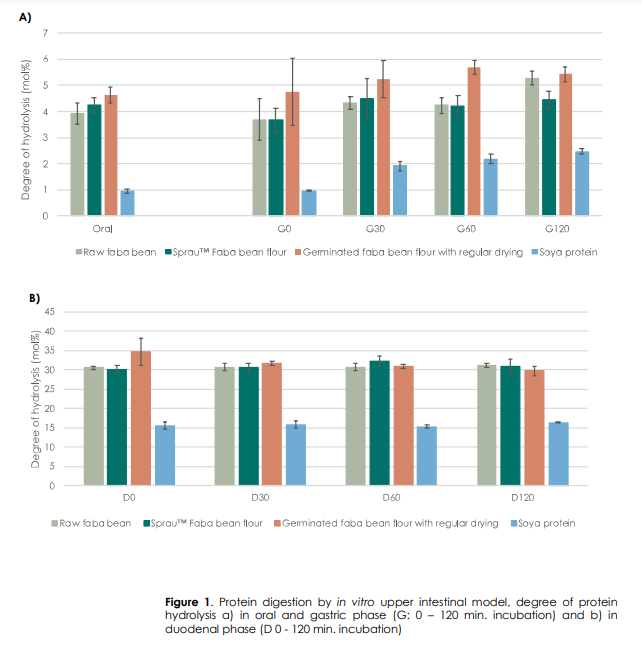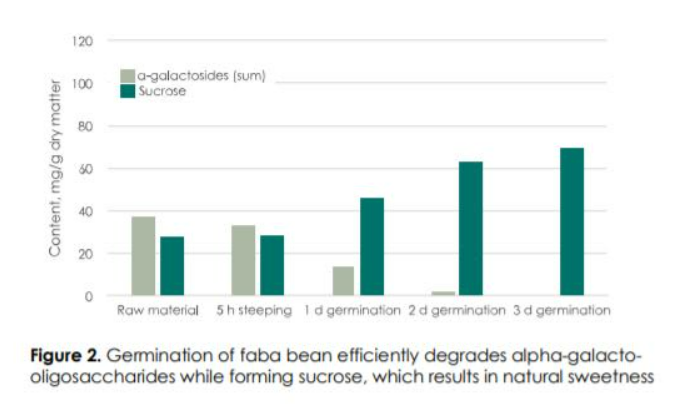Knowde Enhanced TDS
Identification & Functionality
- Ingredient Name
- Ingredient Origin
- Food Ingredients Functions
- Ingredients
- Fava Beans
- Product Families
- Nutritional Composition
- As a drawback to the great nutritional composition of faba beans, they contain some antinutritional factors such as alpha-galactosides, trypsininhibiting activity, phytic acid, and glucopyranosides (vicin and convicin) located in the seed, as well as condensed tannins in the seed coats (Crépon et al., 2010).
- There are breeding efforts towards low tannin and low vicinconvicin varieties and some of them are already being cultivated (Duc et al., 2015).
- One of the factors limiting the dietary use of pulses is the digestive discomfort they often cause. Pulses are known to contain short-chain carbohydrates, also called as FODMAPs (fermentable oligo-, di- and monosaccharides, and polyols), including for example alpha-galactosides (GOS; raffinose, stachyose, verbascose) (Nyyssölä et al. 2020).
- Alphagalactosides are non-digestible by humans, but are fermented by the microorganisms in the gut, thus causing intestinal discomfort (Thirunathan and Manickavasagan, 2018).
Features & Benefits
- Labeling Claims
- Food Ingredients Features
- Germination makes Faba Beans Easy for Digestion
- Germination greatly affects the galacto-oligosaccharides (GOS).
- The bean efficiently degrades the galacto-oligosaccharides in order to fuel its own awakening and metabolic activity during the first days of germination (Figure 2).
- After just two days of germination only a negligible amount of GOS is present.
- It is noteworthy that GOS content has been shown to be higher in faba bean protein concentrate in comparison to regular flour (Vogelsang-O’Dwyer et al., 2020), and that merely soaking and cooking have a minor effect on GOS content (Njoumi et al., 2019).
- The content of many anti-nutritives, such as trypsin inhibitors, has been reported to decrease during thermal treatments in food processing, for instance, extrusion.
- However, the galacto-oligosaccharides are heat resistant and thermal stress will not decrease their content during food processing (Pasqualone et al., 2019).
- Thus, germinated faba bean flour is an excellent, low FODMAP source of pulse protein and other nutrients for those seeking to avoid the discomfort caused by consuming regular pulses. Varney et al., 2017 have defined the low-FODMAP limit for GOS to be 0.3 g per serving and by germination the serving size can be increased tenfold from ~10 g of regular faba beans to ~100 g of germinated faba beans.
- Sustainability of Faba Beans
- Strong biological nitrogen fixation capability.
- Improving soil fertility.
- Increasing biodiversity.
- Hosting and feeding pollinating insects.
- A shift towards a more sustainable food production requires innovative ways of using faba bean in direct human consumption.
- One such innovation is Sprau®, the germinated faba bean and the spark that strives to awaken a more sustainable now.
- Health & Nutrition Benefits
Easy for digestion:
- Low in antinutritives (e.g. alpha-galactosides and tannins).
- Fast and efficient digestibility of protein.
Great source of macro and micronutrients:
- High in protein (35%).
- High quality protein (amino acid score over 80%).
- Source of dietary fiber (5%).
- High in minerals magnesium, calcium, zinc, potassium and group B vitamins such as folate.
All natural:
- Awakened by nature’s own process of germination.
- Organic upon request.
Applications & Uses
- Markets
- Applications
- Food & Nutrition Applications
- Germination Process
- Germination is an ancient and natural process that awakens the bean to its full potential. In ancient Egypt, people germinated dried faba beans before cooking in order to boost nutrition.
- Germination awakens the metabolic processes within a bean and mobilizes its nutrient reserve by activating its own enzymes, reducing antinutritional factors, improving nutritional quality and making it easier to digest (Setia et al., 2019, Alonso et al., 2005).
- Germination is a clean label processing approach as it exploits the natural processes occurring within the plant seed when it starts its growth.
- This method is contemporary as much as it is ancient.
- Since it aligns with the current trends of consumers seeking for clean label production, it comes as no surprise that germinated or sprouted ingredients are emerging to the market.
- However, most of the ingredients available are based on sprouted cereals, whereas plant-based protein ingredients based on germination do not yet exist on the B2B market.
- As highlighted in Table 1, germination preserves the nutritional value present in the beans: the ingredients made from germinated beans are rich in protein, dietary fiber, as well as minerals, like calcium, iron, magnesium, and potassium.
- Consuming germinated faba beans in everyday diet will easily meet the recommended daily need for these essential micro and macronutrients. We designed a unique, patent pending germination process, with a gentle heat treatment, aimed at enhancing the flavor profile of faba beans.
- The germinated ingredients are available as Sprau™ germinated split beans and Sprau™ germinated bean flour.
- Both have versatile functionality and can be used as hero ingredients, making it possible to bring the nutritional benefits to the consumer through delicious and easy-to-use end-products.
- Application Benefits
Favorable for fermented products:
- Germination releases sugars and amino acids for fermentation.
Mild flavor by our unique treatment:
- Mild, cereal like flavor enabling multiple applications and diversity in flavor design.
Retained, natural functionality of proteins:
- High solubility (typically 75% at pH 7) Good gelling and emulsification properties
Convenient to use:
- Does not require soaking prior to cooking Cooking time: split beans - 20 min, flour - 5 min
Properties
- Nutritional Information
| Value | Units | Test Method / Conditions | |
| Carbohydrates | 52.0 | % | — |
| Of which sugars (as sucrose) | 3.5 | % | — |
| Protein Content | 35.0 | % | — |
| Dietary Fiber | 5.6 | % | — |
| Fat Content | 3.5 | % | — |
| Of which saturated fatty acids | 0.57 | % | — |
| Salt Calculated as NaCl | 0.04 | % | — |
| Folate (vitamin B9) | 119.0 | ug/100g | — |
| Magnesium Content (Mg) | 1130.0 | mg/kg | — |
| Potassium Content (K) | 11940.0 | mg/kg | — |
| Zinc Content (Zn) | 5.9 | mg/kg | — |
| Manganese Content (Mn) | 8.9 | mg/kg | — |
| Calcium Content (Ca) | 504.0 | mg/kg | — |
| Phosphorus Content (P) | 6400.0 | mg/kg | — |
| Moisture Content | 5.5 | % | — |
| Energy Value | 371 | kcal/100 g | — |
| Energy Value | 1568 | kJ/100g | — |
Technical Details & Test Data
- Indispensable Amino Acids Present In Faba Beans
Content mg/g protein Recommendation by WHO (adult) mg/g protein* Amino acid score (AAS)
Histidine 28 15 184 Isoleucine 40 30 133 Leucine 75 59 127 Lysine 61 45 135 S-containing AA (Met+Cys) 19 22 88 Threonine 36 23 157 Iryptophan 9 6 157 Valine 47 39 120 Total indispensable AA 389 277 We analyzed the protein digestibility of germinated and raw faba bean flour using an in vitro upper intestinal model previously described by Minekus et al., (2014), including a series of enzymatic treatments and using enzyme concentrations as described by Aura et al. (1999). The results suggest (Figure 1) that the germinated samples, especially after regular drying, have a slightly higher amount of free amino nitrogen in comparison to the reference in the oral and early gastric phases. This was concluded to be due to protein hydrolysis that has occurred during the germination. However, the differences between the three faba bean samples were less significant in the duodenal phase (Fig. 1 B) , and all three resulted in a higher degree of hydrolysis than soya protein isolate. Thus, the germinated faba bean has amino acid profile which is close to the optimal and, based on the in vitro data, well digested in the human gastrointestinal tract.
- Degree of Hydrolysis

- Germination of Faba Beans


